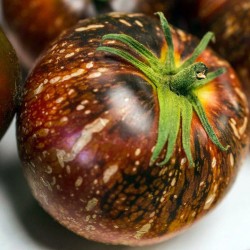Menu
-
MenuInapoi
- Home
-
Categorii
-
-
Categorii
-
Semințe de legume
-
Soiuri după țară
- Soiuri din Armenia
- Soiuri din BiH
- Soiuri din Croația
- Soiuri din Franța
- Varieties from Germany
- Varieties from Greece
- Varieties from Hungary
- Soiuri din India
- Varieties from Italy
- Soiuri din Japonia
- Soiuri din Macedonia de Nord
- Varieties from Peru
- Varieties from Russia
- Varieties from Serbia
- Soiuri din Slovenia
- Varieties from Spain
- Varieties from Thailand
- Soiuri din Turcia
- Varieties from USA
- Semințe de roșii
- Semințe de porumb
- Familia Dovleac
- Familia Bean
- Semințe de castraveți
- Seminte de ardei gras
- Familia morcovului
- Familia ceapa
- Semințe de salată verde
- Familia cartofilor
- Familia de varză
- Semințe de ridiche
- Familia sfeclei
- Semințe de pepene verde
- Semințe de pepene galben
- Semințe de conopidă
- Familia de floarea soarelui
-
Soiuri după țară
- Semințe de fructe
- Seminte de Chili Peppers
- Semințe de plante medicinale
- Semințe de plante cățărătoare
- Copaci - Arbust - Semințe
- Semințe de palmier
- Semințe de ierburi ornamentale
- Semințe de tutun
-
Semințe de legume
-
-
-
-
- PRODUSE NOI
- Crează un cont
- Livrare - Plata
- FAQ
Last Product Reviews
Out of the two seeds, one germinated and the other one was dead and floatin...
By
 Riikka H on 07/03/2024
Riikka H on 07/03/2024
Verified Purchase
Sunt 178 produse.
Se afiseaza 166-178 din 178 produs(e)
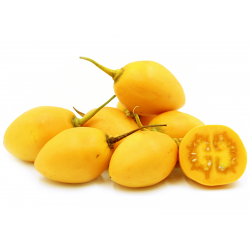
Semințe galbene de...
Pret
2,15 €
(SKU: V 159)
Seeds Gallery EU,
5/
5
<!DOCTYPE html>
<html>
<head>
<meta http-equiv="Content-Type" content="text/html; charset=UTF-8" />
</head>
<body>
<h2><strong>Semințe galbene de Tamarillo (Tamarillo de aur)</strong></h2>
<h2><span style="color: #ff0000;"><strong>Preț pentru pachetul de 5 semințe.</strong></span></h2>
<p>Este încă greu să găsești semințe galbene de tamarillo. Fructul galben de tamarillo are o formă de ou, cu o piele lucioasă de nuanță de mandarină și o carne suculentă care conține semințe mici comestibile moi. Pielea este subțire și bogată în tanin pentru consumul uman plăcut. Carnea sa, când este coaptă, este strălucitoare și picantă în aromă, cu o aromă plăcut dulce.</p>
<p>Golden tamarillo, denumirea botanică Cyphomandra betacea, este, de asemenea, cunoscut sub numele de roșie copac, este un membru al familiei Solanaceae care include roșii, cartofi, tutun și plante de ardei.</p>
</body>
</html>
V 159 (5 S)


Planta rezistenta la frig si inghet
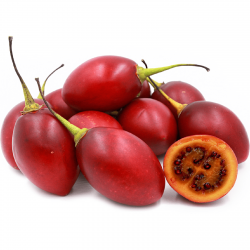
Tamarillo Seeds...
Pret
2,30 €
(SKU: V 113)
Seeds Gallery EU,
5/
5
<h2><span style="color: #000000;"><strong>Tamarillo Seeds (Cyphomandra Betacea)</strong></span></h2>
<h2><span style="color: #ff0000;"><strong>Price for Package of 5<strong> or 10 s</strong>eeds.</strong></span></h2>
<p>Cyphomandra betacea, also known as the tree tomato, or tamarillo, is a small evergreen and fast-growing tree, that originates from several regions of South America, including Peru and Chile. This small tree has large heart-shaped leaves, fragrant flowers that are borne into clusters, red edible fruits.</p>
<p>The tomato tree is frost-hardy to 26°F to 28°F (-2°C to -3°C), and will best be grown in summer.</p>
<p>Newly planted tamarillos should be pruned to a height of 3 to 4 ft. to encourage branching. Yearly pruning thereafter is advisable to eliminate branches that have already fruited and to induce ample new shoots close to the main branches, since fruit is produced on new growth. Pruning also aids in harvesting, and if timed properly can extend the total fruiting period.</p>
<p>Hardiness Zone US 8-11 Aus 2-5 </p>
<div>
<h2><strong>WIKIPEDIA:</strong></h2>
<div><span>The </span><b>tamarillo</b><span> is a small tree or </span>shrub<span> in the </span>flowering plant<span> family </span>Solanaceae<span> (the nightshade family). It is best known as the species that bears the </span><b>tamarillo</b><span>, an egg-shaped edible </span>fruit<span>.</span><sup id="cite_ref-tamarillocom_2-0" class="reference">[2]</sup><span> It is also known as the </span><b>tree tomato</b><span>,</span><sup id="cite_ref-3" class="reference">[3]</sup><span> </span><b>tomate andino</b><span>, </span><b>tomate serrano</b><span>, </span><b>tomate de yuca</b><span>, </span><b>sachatomate</b><span>, </span><b>berenjena</b><span>, </span><b>tamamoro</b><span>, and </span><b>tomate de árbol</b><span> in South America.</span></div>
<div></div>
<div>
<h3><span class="mw-headline" id="Plant_origin_and_regions_of_cultivation">Plant origin and regions of cultivation</span></h3>
<p>The tamarillo is native to the Andes of Ecuador, Colombia, Peru, Chile, and Bolivia. Today it is still cultivated in gardens and small orchards for local production,<sup id="cite_ref-SmallFruitsReview_4-0" class="reference">[4]</sup> and it is one of the most popular fruits in these regions.<sup id="cite_ref-economicBotany_5-0" class="reference">[5]</sup> Other regions of cultivation are the subtropical areas throughout the world, such as Rwanda, South Africa, Darjeeling and Sikkim in India, Nepal, Hong Kong, China, the United States, Australia, Bhutan and New Zealand.<sup id="cite_ref-SmallFruitsReview_4-1" class="reference">[4]</sup></p>
<p>The first internationally marketed crop of tamarillos in Australia was produced around 1996, although permaculture and exotic fruit enthusiasts had increasingly grown the fruit around the country from the mid-1970s on.</p>
<p>In New Zealand, about 2,000 tons are produced on 200 hectares of land and exported to the United States, Japan<sup id="cite_ref-LostCrops_6-0" class="reference">[6]</sup> and Europe. For the export, the existing marketing channels developed for the kiwifruit are used.<sup id="cite_ref-SmallFruitsReview_4-2" class="reference">[4]</sup></p>
<p>The tamarillo is also successfully grown at higher elevations of Malaysia and the Philippines, and in Puerto Rico.<sup id="cite_ref-economicBotany_5-1" class="reference">[5]</sup> In the hot tropical lowlands, it develops only small fruits and fruit setting is seldom.</p>
<p>Prior to 1967, the tamarillo was known as the "tree tomato" in New Zealand, but a new name was chosen by the New Zealand Tree Tomato Promotions Council in order to distinguish it from the ordinary garden tomatoand increase its exotic appeal.</p>
</div>
<span style="color: #ff0000;"><span style="color: #ff0000;"><strong></strong></span></span>
<h3><span class="mw-headline" id="Plant">Plant</span></h3>
<span style="color: #ff0000;"><span style="color: #ff0000;"><strong></strong></span></span>
<div class="thumb tright">
<div class="thumbinner"><img alt="" src="https://upload.wikimedia.org/wikipedia/commons/thumb/3/31/Cyphomandra_betacea1.jpg/220px-Cyphomandra_betacea1.jpg" width="220" height="165" class="thumbimage">
<div class="thumbcaption">
<div class="magnify"></div>
Flower cluster</div>
</div>
</div>
<span style="color: #ff0000;"><span style="color: #ff0000;"><strong></strong></span></span>
<p>The plant is a fast-growing tree that grows up to 5 meters. Peak production is reached after 4 years,<sup id="cite_ref-LostCrops_6-1" class="reference">[6]</sup> and the life expectancy is about 12 years.<sup id="cite_ref-SmallFruitsReview_4-3" class="reference">[4]</sup> The tree usually forms a single upright trunk with lateral branches. The flowers and fruits hang from the lateral branches. The leaves are large, simple and perennial, and have a strong pungent smell.<sup id="cite_ref-LostCrops_6-2" class="reference">[6]</sup> The flowers are pink-white, and form clusters of 10 to 50 flowers. They produce 1 to 6 fruits per cluster. Plants can set fruit without cross-pollination, but the flowers are fragrant and attract insects. Cross-pollination seems to improve fruit set.<sup id="cite_ref-LostCrops_6-3" class="reference">[6]</sup> The roots are shallow and not very pronounced, therefore the plant is not tolerant of drought stress and can be damaged by strong winds. Tamarillos will hybridize with many other solanaceae, though the hybrid fruits will be sterile, and unpalatable in some instances.</p>
<span style="color: #ff0000;"><span style="color: #ff0000;"><strong></strong></span></span>
<h3><span class="mw-headline" id="Fruit">Fruit</span></h3>
<span style="color: #ff0000;"><span style="color: #ff0000;"><strong></strong></span></span>
<div class="thumb tright">
<div class="thumbinner"><img alt="" src="https://upload.wikimedia.org/wikipedia/commons/thumb/9/9a/Solanum_betaceum_unripe_fruits.jpg/220px-Solanum_betaceum_unripe_fruits.jpg" width="220" height="146" class="thumbimage">
<div class="thumbcaption">
<div class="magnify"></div>
Unripe fruits</div>
</div>
</div>
<span style="color: #ff0000;"><span style="color: #ff0000;"><strong></strong></span></span>
<div class="thumb tright">
<div class="thumbinner"><img alt="" src="https://upload.wikimedia.org/wikipedia/commons/thumb/0/00/Tamarillos%28janek2005%29.jpg/220px-Tamarillos%28janek2005%29.jpg" width="220" height="182" class="thumbimage">
<div class="thumbcaption">
<div class="magnify"></div>
Ripe fruits</div>
</div>
</div>
<span style="color: #ff0000;"><span style="color: #ff0000;"><strong></strong></span></span>
<p>The fruits are egg-shaped and about 4-10 centimeters long. Their color varies from yellow and orange to red and almost purple. Sometimes they have dark, longitudinal stripes. Red fruits are more acetous, yellow and orange fruits are sweeter. The flesh has a firm texture and contains more and larger seeds than a common tomato.<sup id="cite_ref-SmallFruitsReview_4-4" class="reference">[4]</sup> The fruits are very high in vitamins and iron and low in calories (only about 40 calories per fruit).</p>
<span style="color: #ff0000;"><span style="color: #ff0000;"><strong></strong></span></span>
<h3><span class="mw-headline" id="Soil_and_climate_requirements">Soil and climate requirements</span></h3>
<span style="color: #ff0000;"><span style="color: #ff0000;"><strong></strong></span></span>
<p>The tamarillo prefers subtropical climate, with rainfall between 600 and 4000 millimeters and annual temperatures between 15 and 20 °C.<sup id="cite_ref-SmallFruitsReview_4-6" class="reference">[4]</sup> It is intolerant to frost (below -2 °C) and drought stress. It is assumed that fruit set is affected by night temperatures. Areas where citrus are cultivated provide good conditions for tamarillos as well, such as in the Mediterranean climate. Tamarillo plants grow best in light, deep, fertile soils, although they are not very demanding. However, soils must be permeable since the plants are not tolerant to water-logging.<sup id="cite_ref-SmallFruitsReview_4-7" class="reference">[4]</sup> They grow naturally on soils with a pH of 5 to 8.5.</p>
<span style="color: #ff0000;"><span style="color: #ff0000;"><strong></strong></span></span>
<h3><span class="mw-headline" id="Growth">Growth</span></h3>
<span style="color: #ff0000;"><span style="color: #ff0000;"><strong></strong></span></span>
<p>Propagation is possible by both using seeds or cuttings.<sup id="cite_ref-SmallFruitsReview_4-8" class="reference">[4]</sup><sup id="cite_ref-7" class="reference">[7]</sup> Seedlings first develop a straight, about 1.5 to 1.8 meters tall trunk, before they branch out. Propagation by seeds is easy and ideal in protected environments. However, in orchards with different cultivars, cross-pollination will occur and characteristics of the cultivars get mixed up. Seedlings should be kept in the nursery until they reach a height of 1 to 1.5 meters, as they are very frost-sensitive.</p>
<span style="color: #ff0000;"><span style="color: #ff0000;"><strong></strong></span></span>
<p>Plants grown from cuttings branch out earlier and result in more shrub-like plants that are more suitable for exposed sites. Cuttings should be made from basal and aerial shoots, and should be free of pathogenic viruses. Plants grown from cuttings should be kept in the nursery until they reach a height of 0.5 to 1 meter.</p>
<span style="color: #ff0000;"><span style="color: #ff0000;"><strong></strong></span></span>
<p>The tree grows very quickly and is able to bear fruit after 1.5 to 2 years.<sup id="cite_ref-economicBotany_5-2" class="reference">[5]</sup> The plant is daylength-insensitive. The fruits do not mature simultaneously, unless the tree has been pruned. A single tree can produce more than 20 kg of fruit per year; an orchard yields in 15 to 17 tons per hectare.<sup id="cite_ref-LostCrops_6-5" class="reference">[6]</sup> One single mature tree in good soil will bear more fruit than a typical family can eat in about 3 months.</p>
<span style="color: #ff0000;"><span style="color: #ff0000;"><strong></strong></span></span>
<p>Tamarillos are suitable for growing as indoor container plants, though their swift growth, their light, water and humidity requirements and their large leaves can pose a challenge to those with limited space.</p>
<span style="color: #ff0000;"><span style="color: #ff0000;"><strong></strong></span></span>
<h3><span class="mw-headline" id="Plant_management">Plant management</span></h3>
<span style="color: #ff0000;"><span style="color: #ff0000;"><strong></strong></span></span>
<div class="thumb tright">
<div class="thumbinner"><img alt="" src="https://upload.wikimedia.org/wikipedia/commons/thumb/0/0a/Cyphomandra_betacea2.jpg/220px-Cyphomandra_betacea2.jpg" width="220" height="293" class="thumbimage">
<div class="thumbcaption">
<div class="magnify"></div>
Tamarillo tree</div>
</div>
</div>
<span style="color: #ff0000;"><span style="color: #ff0000;"><strong></strong></span></span>
<p>The tamarillo trees are adaptable and very easy to grow. However, some plant management strategies can help to stabilize and improve plant performance.</p>
<span style="color: #ff0000;"><span style="color: #ff0000;"><strong></strong></span></span>
<h4><span class="mw-headline" id="Planting">Planting</span></h4>
<span style="color: #ff0000;"><span style="color: #ff0000;"><strong></strong></span></span>
<p>Planting distances depend on the growing system. In New Zealand, with mechanized production, single row planting distances of 1 to 1.5 meters between plants and 4.5 to 5 meters between rows are recommended. In traditional growing regions such as the Andean region, plantations are much more dense, with 1.2 to 1.5 meters between plants. Dense planting can be a strategy to protect plants against wind.<sup id="cite_ref-SmallFruitsReview_4-9" class="reference">[4]</sup> On poorly drained soils, plants should be planted on ridges.</p>
<span style="color: #ff0000;"><span style="color: #ff0000;"><strong></strong></span></span>
<h4><span class="mw-headline" id="Pruning">Pruning</span></h4>
<span style="color: #ff0000;"><span style="color: #ff0000;"><strong></strong></span></span>
<p>Pruning can help to control fruit size, plant size, harvest date and to simplify the harvesting of fruits.<sup id="cite_ref-SmallFruitsReview_4-10" class="reference">[4]</sup> Cutting the tip of young plants leads to the desired branch height. Once the tree shape has been formed, pruning is reduced to the removal of old or dead wood and previously fruited branches, since branches that have already carried fruits will produce smaller fruits with lower quality the next time. Light pruning leads to medium-sized, heavy pruning to large sized fruits. Basal shoots should be removed. When plants are grown in greenhouses, pruning prevents excessive vegetative growth.</p>
<span style="color: #ff0000;"><span style="color: #ff0000;"><strong></strong></span></span>
<p>When the tree is about 1 to 1.5 metres in height, it is advisable to cut the roots on one side and lean the tree to the other (in the direction of the midday sun at about 30 to 45 degrees). This allows fruiting branches to grow all along the trunk rather than just at the top.</p>
<span style="color: #ff0000;"><span style="color: #ff0000;"><strong></strong></span></span>
<div class="thumb tright">
<div class="thumbinner"><img alt="" src="https://upload.wikimedia.org/wikipedia/commons/thumb/e/e3/Tamarillo_seedlings%2C_6_months_old.jpg/220px-Tamarillo_seedlings%2C_6_months_old.jpg" width="220" height="215" class="thumbimage">
<div class="thumbcaption">
<div class="magnify"></div>
Tamarillo seedlings, 6 months old</div>
</div>
</div>
<span style="color: #ff0000;"><span style="color: #ff0000;"><strong></strong></span></span>
<h4><span class="mw-headline" id="Mulching">Mulching</span></h4>
<span style="color: #ff0000;"><span style="color: #ff0000;"><strong></strong></span></span>
<p>Since the plants are sensitive to drought stress, mulching can help to preserve moisture in the soil.<sup id="cite_ref-LostCrops_6-6" class="reference">[6]</sup> It can also be a strategy to suppress weeds, as other soil management techniques, such as plowing, are not possible due to the shallow and sensitive root system.</p>
<span style="color: #ff0000;"><span style="color: #ff0000;"><strong></strong></span></span>
<h4><span class="mw-headline" id="Shelter">Shelter</span></h4>
<span style="color: #ff0000;"><span style="color: #ff0000;"><strong></strong></span></span>
<p>The plants have to be protected from wind. Their shallow root system does not provide enough stability, and the lateral branches are fragile and break easily when carrying fruits.<sup id="cite_ref-SmallFruitsReview_4-11" class="reference">[4]</sup></p>
<span style="color: #ff0000;"><span style="color: #ff0000;"><strong></strong></span></span>
<h4><span class="mw-headline" id="Irrigation_and_fertilization">Irrigation and fertilization</span></h4>
<span style="color: #ff0000;"><span style="color: #ff0000;"><strong></strong></span></span>
<p>To maximize and stabilize production, water and nutrient inputs should be provided when needed. The plants need continuous supply of water due to their shallow root system. Drought stress results in a decrease of plant growth, fruit size and productivity.<sup id="cite_ref-SmallFruitsReview_4-12" class="reference">[4]</sup> Recommended fertilizer rates per hectare are 170 kg of Nitrogen, 45 kg of Phosphorus and 130 to 190 kg of Potassium for intensive New Zealand production systems. Phosphorus and Potassium are applied in the beginning of the season, Nitrogen applications are distributed throughout the year.<sup id="cite_ref-SmallFruitsReview_4-13" class="reference">[4]</sup></p>
<span style="color: #ff0000;"><span style="color: #ff0000;"><strong></strong></span></span>
<h4><span class="mw-headline" id="Pest_management">Pest management</span></h4>
<span style="color: #ff0000;"><span style="color: #ff0000;"><strong></strong></span></span>
<p>The tamarillo tree is, compared to similar crops such as tomatoes, quite resistant to pests in general. Still, to reduce risk in intensive production systems, some pests have to be controlled to avoid major crop damage. To control pests, the same control methods as for other solanaceae can be used.</p>
<span style="color: #ff0000;"><span style="color: #ff0000;"><strong></strong></span></span>
<h3><span class="mw-headline" id="Harvest">Harvest</span></h3>
<span style="color: #ff0000;"><span style="color: #ff0000;"><strong></strong></span></span>
<p>Ripening of fruits is not simultaneous. Several harvests are necessary.<sup id="cite_ref-8" class="reference">[8]</sup> In climates with little annual variation, tamarillo trees can flower and set fruit throughout the year. In climates with pronounced seasons (such as New Zealand), fruits ripen in autumn. Premature harvest and ethylene induced ripening in controlled-atmosphere chambers is possible with minimal loss of fruit quality.<sup id="cite_ref-Ripening_9-0" class="reference">[9]</sup> The fragile lateral branches can break easily when loaded with fruits, so premature harvest helps to reduce this risk and allows storage of fruits up to 20 days at room temperature. A cold-water dipping process, developed by the New Zealand Department of Scientific and Industrial Research also allows further storage of 6–10 weeks.<sup id="cite_ref-SmallFruitsReview_4-14" class="reference">[4]</sup></p>
<span style="color: #ff0000;"><span style="color: #ff0000;"><strong></strong></span></span>
<h2><span class="mw-headline" id="Usage">Usage</span></h2>
<span style="color: #ff0000;"><span style="color: #ff0000;"><strong></strong></span></span>
<h3><span class="mw-headline" id="Culinary_use">Culinary use</span></h3>
<span style="color: #ff0000;"><span style="color: #ff0000;"><strong></strong></span></span>
<p>The fruit is eaten by scooping the flesh from a halved fruit. When lightly sugared and cooled, the flesh is used for a breakfast dish. Some people in New Zealand cut the fruit in half, scoop out the pulpy flesh and spread it on toast at breakfast. Yellow-fruited cultivars have a sweeter flavor, occasionally compared to mango or apricot. The red-fruited variety, which is much more widely cultivated, is more tart, and the savory aftertaste is far more pronounced. In the Northern Hemisphere, tamarillos are most frequently available from July until November, and fruits early in the season tend to be sweeter and less astringent.</p>
<span style="color: #ff0000;"><span style="color: #ff0000;"><strong></strong></span></span>
<p>They can be made into compotes, or added to stews (e.g. Boeuf Bourguignon), hollandaise, chutneys and curries. Desserts using this fruit include bavarois and, combined with apples, a strudel.</p>
<span style="color: #ff0000;"><span style="color: #ff0000;"><strong></strong></span></span>
<p>Tamarillos can be added as a secondary fermentation flavouring to Kombucha Tea for a tart and tangy taste. The fruit should be mashed and added at a ratio of 3 Tamarillos to 1 Litre of Kombucha, however great care should be taken to not allow too much carbon dioxide gas to build up in sealed bottles during secondary fermentation. The sugar content of fresh Tamarillos added to Kombucha can generate a rapid carbon dioxide production in secondary fermentation within just 48–72 hours.</p>
<span style="color: #ff0000;"><span style="color: #ff0000;"><strong></strong></span></span>
<p>In Colombia, Ecuador, Panama and parts of Indonesia (including Sumatra and Sulawesi), fresh tamarillos are frequently blended together with water and sugar to make a juice. It is also available as a commercially pasteurized purée.</p>
<span style="color: #ff0000;"><span style="color: #ff0000;"><strong></strong></span></span>
<p>In Nepal, a version of the South American fruit is decently popular. It is typically consumed as a chutney or a pickle during the autumn and winter months. It is known as <i>Tammatar</i> and <i>Ram Bheda</i>. Similar to Nepal, the Indian regions of Ooty, Darjeeling and Sikkim also consume Tamarillo.</p>
<span style="color: #ff0000;"><span style="color: #ff0000;"><strong></strong></span></span>
<p>In Ecuador, the tamarillo, known as <i>tomate de árbol</i>, is blended with chili peppers to make a hot sauce commonly consumed with local dishes of the Andean region. The sauce is simply referred to as <i>aji</i> and is present at every meal in Ecuador.</p>
<span style="color: #ff0000;"><span style="color: #ff0000;"><strong></strong></span></span>
<p>The flesh of the tamarillo is tangy and variably sweet, with a bold and complex flavor, and may be compared to kiwifruit, tomato, guava, or passion fruit. The skin and the flesh near it have a bitter taste and are not usually eaten raw</p>
<span style="color: #ff0000;"><span style="color: #ff0000;"><strong></strong></span></span>
<p>The tamarillo has been described as having a taste similar to that of a passion fruit and a piquant tomato combined.<sup class="noprint Inline-Template Template-Fact">[<i><span title="This claim needs references to reliable sources. (January 2009)">citation needed</span></i>]</sup></p>
<span style="color: #ff0000;"><span style="color: #ff0000;"><strong></strong></span></span>
<p>The red and purple types of fruits are preferred in import countries of Europe: Even though they taste more acidic, their color is favoured by consumers.<sup id="cite_ref-SmallFruitsReview_4-15" class="reference">[4]</sup></p>
<span style="color: #ff0000;"><span style="color: #ff0000;"><strong></strong></span></span>
<h3><span class="mw-headline" id="Industrial_use">Industrial use</span></h3>
<span style="color: #ff0000;"><span style="color: #ff0000;"><strong></strong></span></span>
<p>The fruits are high in pectin and therefore have good properties for preserves. However, they oxidize and lose color when not treated. Yellow fruit types are better suited to industrial use.</p>
<span style="color: #ff0000;"><span style="color: #ff0000;"><strong></strong></span></span>
<h2><span class="mw-headline" id="Prospects">Prospects</span></h2>
<span style="color: #ff0000;"><span style="color: #ff0000;"><strong></strong></span></span>
<p>Research and breeding should improve plantation management, fruit quality and postharvest treatment.<sup id="cite_ref-LostCrops_6-7" class="reference">[6]</sup> A better understanding of plant physiology, nutritional requirements of plants and fruit set mechanisms will help to improve growing systems. Breeding goals are to break seed dormancy, to improve sweetness of fruits and to increase yield. For industrial uses, little "stones" of sodium and calcium that occasionally appear in the fruit skin form a problem. Those stones have to be eliminated by breeding.</p>
<span style="color: #ff0000;"><strong><br></strong></span></div>
<div></div><script src="//cdn.public.n1ed.com/G3OMDFLT/widgets.js"></script>
V 113 (10 S)


Varietate din Statele Unite ale Americii

1500 semințe Heinz 1350 Tomate
Pret
12,95 €
(SKU: VT 101 (5g))
Seeds Gallery EU,
5/
5
<h2><strong>1500 semințe Heinz 1350 Tomate</strong></h2>
<h2><span style="color: #ff0000;"><strong>Preț pentru pachetul de 1500 (5g) semințe.</strong></span></h2>
<p><span class="VIiyi" jsaction="mouseup:BR6jm" jsname="jqKxS" lang="ro"><span jsaction="agoMJf:PFBcW;usxOmf:aWLT7;jhKsnd:P7O7bd,F8DmGf;Q4AGo:Gm7gYd,qAKMYb;uFUCPb:pvnm0e,pfE8Hb,PFBcW;f56efd:dJXsye;EnoYf:KNzws,ZJsZZ,JgVSJc;zdMJQc:cCQNKb,ZJsZZ,zchEXc;Ytrrj:JJDvdc;tNR8yc:GeFvjb;oFN6Ye:hij5Wb" jscontroller="Zl5N8" jsmodel="SsMkhd" jsname="txFAF" class="JLqJ4b ChMk0b" data-language-for-alternatives="ro" data-language-to-translate-into="en" data-phrase-index="4" jsdata="uqLsIf;_;$63"><span jsaction="click:qtZ4nf,GFf3ac,tMZCfe; contextmenu:Nqw7Te,QP7LD; mouseout:Nqw7Te; mouseover:qtZ4nf,c2aHje" jsname="W297wb">Savurați aroma clasică de roșii adăugând această moștenire în lista dvs. de grădină.</span></span> <span jsaction="agoMJf:PFBcW;usxOmf:aWLT7;jhKsnd:P7O7bd,F8DmGf;Q4AGo:Gm7gYd,qAKMYb;uFUCPb:pvnm0e,pfE8Hb,PFBcW;f56efd:dJXsye;EnoYf:KNzws,ZJsZZ,JgVSJc;zdMJQc:cCQNKb,ZJsZZ,zchEXc;Ytrrj:JJDvdc;tNR8yc:GeFvjb;oFN6Ye:hij5Wb" jscontroller="Zl5N8" jsmodel="SsMkhd" jsname="txFAF" class="JLqJ4b ChMk0b" data-language-for-alternatives="ro" data-language-to-translate-into="en" data-phrase-index="5" jsdata="uqLsIf;_;$64"><span jsaction="click:qtZ4nf,GFf3ac,tMZCfe; contextmenu:Nqw7Te,QP7LD; mouseout:Nqw7Te; mouseover:qtZ4nf,c2aHje" jsname="W297wb">Una dintre primele soiuri de semințe de roșii Heinz care a fost folosită pentru a face ketchup-ul Heinz, roșia Heinz Classic Heirloom (cunoscută și sub numele de Heinz 1370) oferă o aromă bogată de roșii în fructe mari (aproximativ 170g), suculente, ideale pentru felierea pe sandvișuri sau gătit</span></span> <span jsaction="agoMJf:PFBcW;usxOmf:aWLT7;jhKsnd:P7O7bd,F8DmGf;Q4AGo:Gm7gYd,qAKMYb;uFUCPb:pvnm0e,pfE8Hb,PFBcW;f56efd:dJXsye;EnoYf:KNzws,ZJsZZ,JgVSJc;zdMJQc:cCQNKb,ZJsZZ,zchEXc;Ytrrj:JJDvdc;tNR8yc:GeFvjb;oFN6Ye:hij5Wb" jscontroller="Zl5N8" jsmodel="SsMkhd" jsname="txFAF" class="JLqJ4b ChMk0b" data-language-for-alternatives="ro" data-language-to-translate-into="en" data-phrase-index="6" jsdata="uqLsIf;_;$65"><span jsaction="click:qtZ4nf,GFf3ac,tMZCfe; contextmenu:Nqw7Te,QP7LD; mouseout:Nqw7Te; mouseover:qtZ4nf,c2aHje" jsname="W297wb">în sosuri sau tocană.</span></span><span jsaction="agoMJf:PFBcW;usxOmf:aWLT7;jhKsnd:P7O7bd,F8DmGf;Q4AGo:Gm7gYd,qAKMYb;uFUCPb:pvnm0e,pfE8Hb,PFBcW;f56efd:dJXsye;EnoYf:KNzws,ZJsZZ,JgVSJc;zdMJQc:cCQNKb,ZJsZZ,zchEXc;Ytrrj:JJDvdc;tNR8yc:GeFvjb;oFN6Ye:hij5Wb" jscontroller="Zl5N8" jsmodel="SsMkhd" jsname="txFAF" class="JLqJ4b" data-language-for-alternatives="ro" data-language-to-translate-into="en" data-phrase-index="7" jsdata="uqLsIf;_;$66"><span jsaction="click:qtZ4nf,GFf3ac,tMZCfe; contextmenu:Nqw7Te,QP7LD; mouseout:Nqw7Te; mouseover:qtZ4nf,c2aHje" jsname="W297wb"> </span></span></span></p>
<p><span class="VIiyi" jsaction="mouseup:BR6jm" jsname="jqKxS" lang="ro"><span jsaction="agoMJf:PFBcW;usxOmf:aWLT7;jhKsnd:P7O7bd,F8DmGf;Q4AGo:Gm7gYd,qAKMYb;uFUCPb:pvnm0e,pfE8Hb,PFBcW;f56efd:dJXsye;EnoYf:KNzws,ZJsZZ,JgVSJc;zdMJQc:cCQNKb,ZJsZZ,zchEXc;Ytrrj:JJDvdc;tNR8yc:GeFvjb;oFN6Ye:hij5Wb" jscontroller="Zl5N8" jsmodel="SsMkhd" jsname="txFAF" class="JLqJ4b ChMk0b" data-language-for-alternatives="ro" data-language-to-translate-into="en" data-phrase-index="8" jsdata="uqLsIf;_;$67"><span jsaction="click:qtZ4nf,GFf3ac,tMZCfe; contextmenu:Nqw7Te,QP7LD; mouseout:Nqw7Te; mouseover:qtZ4nf,c2aHje" jsname="W297wb">Plantele (120-150 centimetri înălțime) prosperă în multe regiuni și se adaptează bine la creșterea în containere mari.</span></span> <span jsaction="agoMJf:PFBcW;usxOmf:aWLT7;jhKsnd:P7O7bd,F8DmGf;Q4AGo:Gm7gYd,qAKMYb;uFUCPb:pvnm0e,pfE8Hb,PFBcW;f56efd:dJXsye;EnoYf:KNzws,ZJsZZ,JgVSJc;zdMJQc:cCQNKb,ZJsZZ,zchEXc;Ytrrj:JJDvdc;tNR8yc:GeFvjb;oFN6Ye:hij5Wb" jscontroller="Zl5N8" jsmodel="SsMkhd" jsname="txFAF" class="JLqJ4b ChMk0b" data-language-for-alternatives="ro" data-language-to-translate-into="en" data-phrase-index="9" jsdata="uqLsIf;_;$68"><span jsaction="click:qtZ4nf,GFf3ac,tMZCfe; contextmenu:Nqw7Te,QP7LD; mouseout:Nqw7Te; mouseover:qtZ4nf,c2aHje" jsname="W297wb">Plantele Heinz Classic Heirloom poartă fructe pe tot parcursul sezonului, dar coacă cea mai grea porțiune a culturii vara.</span></span> <span jsaction="agoMJf:PFBcW;usxOmf:aWLT7;jhKsnd:P7O7bd,F8DmGf;Q4AGo:Gm7gYd,qAKMYb;uFUCPb:pvnm0e,pfE8Hb,PFBcW;f56efd:dJXsye;EnoYf:KNzws,ZJsZZ,JgVSJc;zdMJQc:cCQNKb,ZJsZZ,zchEXc;Ytrrj:JJDvdc;tNR8yc:GeFvjb;oFN6Ye:hij5Wb" jscontroller="Zl5N8" jsmodel="SsMkhd" jsname="txFAF" class="JLqJ4b ChMk0b" data-language-for-alternatives="ro" data-language-to-translate-into="en" data-phrase-index="10" jsdata="uqLsIf;_;$69"><span jsaction="click:qtZ4nf,GFf3ac,tMZCfe; contextmenu:Nqw7Te,QP7LD; mouseout:Nqw7Te; mouseover:qtZ4nf,c2aHje" jsname="W297wb">Mizați aceste plante viguroase pentru cele mai bune rezultate și recoltarea cea mai ușoară.</span></span></span><span> </span></p><script src="//cdn.public.n1ed.com/G3OMDFLT/widgets.js"></script>
VT 101 (5g)


Varietate din Peru
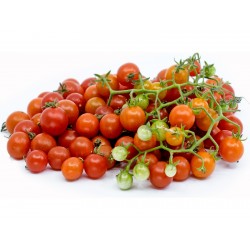
Semințe de roșii sălbatice...
Pret
1,85 €
(SKU: VT 113)
Seeds Gallery EU,
5/
5
<h2 style="font-family: 'Helvetica Neue', Helvetica, Arial, sans-serif; color: #333333;" class=""><strong>Semințe de roșii sălbatice (Solanum pimpinellifolium)</strong></h2>
<h2 style="font-family: 'Helvetica Neue', Helvetica, Arial, sans-serif; color: #333333;"><span style="color: #ff0303;"><strong>Preț pentru pachetul de 5 semințe.</strong></span></h2>
<p><strong>Roșii roșii mici, delicioase, care cresc din abundență.</strong><br><br>Roșiile de coacăze roșii sunt cea mai mică roșie comestibilă, fiecare fruct cântărind în medie doar trei grame și măsoară puțin peste un centimetru în diametru. Fructele rotunde, galbene, se remarcă prin aroma lor intensă, dulce-tartă și textura fermă și suculentă. Au o piele subțire lucioasă, cu două celule interioare, care tind să fie dezastruoase, dar ambalează o aromă de roșie adevărată, extrem de dulce, datorită nivelurilor ridicate de zahăr și acid. Plantele puternice, întinse, nedeterminate, sunt rezistente la boli și cu randament ridicat, producând cantități abundente de fructe mici pe tot parcursul sezonului. Plantele au frunze mici, delicate, cu un miros mai acru decât alte soiuri, iar tulpinile plantelor sunt mici și slabe.<br><br>Anotimpuri / Disponibilitate<br><br>Roșiile de coacăze galbene sunt disponibile vara și toamna.<br><br>Fapte actuale<br><br>Roșiile de coacăze roșii sunt membri ai familiei mari și diverse Solanaceae, cunoscută și sub numele de familia Nightshade, care include mai mult de trei mii de specii cunoscute. Roșiile de coacăze sunt numite botanic Solanum Pimpinellifolium, o specie independentă de roșii și una dintre cele două specii comestibile alături de roșia comună, Lycopersicon esculentum Fructul în miniatură atârnă în ciorchini asemănători coacăzelor, de unde și numele lor. Există numeroase soiuri de roșii coacăze, atât roșu cât și galben, inclusiv mazăre dulce, prune de zahăr și hawaiiene, care sunt considerate a fi printre cele mai dulci soiuri. Roșiile de coacăze s-au dovedit a fi foarte valoroase din punct de vedere științific, deoarece sunt strâns legate de una dintre speciile sălbatice originale, care crește în apropierea coastelor nordului Peru, iar ADN-ul lor a fost punctul de plecare pentru compararea evoluției genelor din familia Solanaceae. Deși roșiile de coacăze sunt o specie diferită, acestea se vor încrucișa ușor cu roșiile de grădină și, datorită rezistenței lor la boli și a obiceiului lor de a produce fructe în ferme lungi, roșiile de coacăze s-au încrucișat cu alte tipuri de roșii pentru a crea multe dintre soiurile moderne de roșii cherry .<br><br>Zile până la maturitate: 60 de zile<br><br>Greutatea fructelor: 1 uncie<br><br>Soare: Soare plin<br><br>Răspândire: 18 inci<br><br>Înălțime: 36-40 inci<br><br>Metoda de scroafă: Scroafă de interior<br><br>Timp de plantare: primăvară<br><br>Timp de semănat: 6-8 săptămâni BLF<br><br>Subțire: 18 inci<br><br>Ciclul de viață: anual</p><script src="//cdn.public.n1ed.com/G3OMDFLT/widgets.js"></script>
VT 113 (5 S)


Varietate din Statele Unite ale Americii
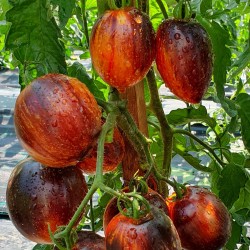
Semințe de roșii Gargamel
Pret
1,85 €
(SKU: VT 4 G)
Seeds Gallery EU,
5/
5
<h2 class=""><strong>Semințe de roșii Gargamel</strong></h2>
<h2><span style="color: #f80000;"><strong>Preț pentru un pachet de 10 semințe.</strong></span></h2>
O nouă varietate de roșii originare din SUA, de la cultivatorii Phil Seneca (Pittsburgh, Pennsylvania, SUA). Acest soi a fost numit după un personaj fictiv din Strumfi. Gargamel, vrăjitorul rău care este principalul antagonist al ștrumfilor, poartă o mantie neagră și pantofi roșii, iar culorile negre și roșii ale fructului amintesc de hainele lui Gargamel.<br><br>Planta este puternică, crește înaltă, crește peste 180 cm în înălțime.<br><br>Poate fi cultivat pe două tulpini principale, iar tăierea este necesară.<br><br>Fructul este oval, iar unele dintre ele au vârfuri ascuțite. Greutatea fructului este de aproximativ 3,5-4,2 oz. (100-120 g). Culoarea fructului nu vă va lăsa indiferent. Sunt negre lângă tulpină și portocalii cu dungi roșii și maronii în partea de sus. Fructele seamănă cu flori de culoare flacără.<br><br>Gustul este dulce, fructat și roșu. Pereții sunt solizi și dulci.<br><br>Această roșie va fi garnitura perfectă pentru felurile dvs. de mâncare. Delicios să mănânci și proaspăt.<br><br>Este o alegere bună pentru uscare la soare. De asemenea, o alegere bună pentru conservarea fructelor întregi.
<script src="//cdn.public.n1ed.com/G3OMDFLT/widgets.js"></script>
VT 4 G (10 S)

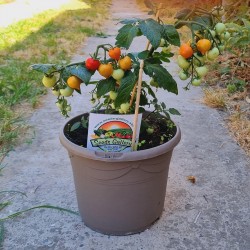
Semințe de roșii pitice Evita
Pret
2,25 €
(SKU: VT 37)
Seeds Gallery EU,
5/
5
<h2><strong>Semințe de roșii pitice Evita</strong></h2>
<h2><span style="color: #f80000;"><strong>Preț pentru pachetul de 5 semințe.</strong></span></h2>
Roșia de inimă Evita (Solanum lycopersicum) produce fructe mici care au gust dulce, intens și pot fi recoltate încă din iulie. Pentru creșterea optimă a roșiei Evita, este necesară o locație însorită și un sol permeabil, bogat în nutrienți.<br><br>UTILIZARE<br>Consum proaspăt, gătit, salată, sos / baie, supă / tocană<br><br>CREŞTERE<br>Drept. Creștere rapidă.<br><br>FRUCTE<br>Fructele roșii aprinse, mici, au un gust dulce, intens. Timp de coacere din iulie. Fructele sunt rotunde, în formă de păstăi.<br><br>LOCAȚIE<br>Locație preferată într-o locație însorită.<br><br>SOL<br>Sol preferat bogat în humus.<br><br>APĂ<br>Udați regulat și lăsați solul să se usuce între timp.<br><br>ÎNTREȚINERE<br>Este recomandabil să trageți șanțuri de irigare între rânduri, deoarece multe tipuri de legume nu trebuie udate de sus. În plus: plivirea regulată împiedică buruienile să le răpească legumelor puterea lor.<br><br>PARTENERI DE PLANTE<br>Buni parteneri de plantare: busuioc, nasturțium, pătrunjel creț, mentă, gălbenele, gălbenele, lemn de pădure, zinnia.<br><br>TIMP DE PLANTARE<br>Plantare: primăvară-vară.<br><br>TIMPUL DE SEMANARE<br>Semănați în aer liber în luna mai.<br>Acoperiți semințele de 0,5 - 1 cm cu sol. Germinarea are loc în decurs de 6-10 zile la temperatura solului la 15 ° C.<script src="//cdn.public.n1ed.com/G3OMDFLT/widgets.js"></script>
VT 37 (5 S)


Varietate din Rusia
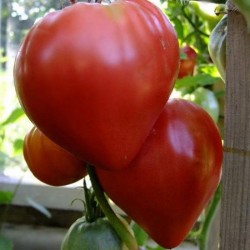
Semințele de roșii...
Pret
1,65 €
(SKU: VT 80)
Seeds Gallery EU,
5/
5
<h2 class=""><strong>Semințele de roșii siberiene Inima Vulturului</strong></h2>
<h2><span style="color: #f80000;"><strong>Preț pentru pachetul de 10 semințe.</strong></span></h2>
Tomatul siberian Eagle Heart este o inimă de bou colorată în mod unic, care este o priveliște de văzut.<br>În mijlocul sezonului, cu randament ridicat, grad mare de fructe de selecție pentru amatori. 300g fructe de roșii cu o formă frumoasă în formă de inimă extinsă, de culoare roz și purpuriu, cu pulpă dulce blândă. Aceasta este o roșie foarte cărnoasă și netedă, care este dulce și delicioasă.<br><br>Dens, nu apos, constant împotriva crăpăturilor. Planta este puternică, foarte rezistentă la boli și condiții meteorologice nefavorabile. Este potrivit pentru câmpuri deschise și sere.<br>80 de zile.<script src="//cdn.public.n1ed.com/G3OMDFLT/widgets.js"></script>
VT 80 (10)


Varietate din Germania
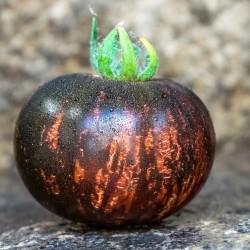
Seminte de rosii Regina Nopții
Pret
1,85 €
(SKU: VT 123)
Seeds Gallery EU,
5/
5
<h2><strong>Seminte de rosii Regina Nopții</strong></h2>
<h2><span style="color: #f80000;"><strong>Preț pentru un pachet de 10 semințe.</strong></span></h2>
Königin der Nacht - Regina nopții este un soi albastru recent din zona Rinului, Germania. Ceea ce știm sigur este că acest nou soi provine din Germania din zona Rinului și nu se cunosc informații suplimentare.<br><br>Fructele rotunde cu dungi roșu-portocalii cu influențe foarte puternice albastru-negru pe jumătatea superioară din antocianină. Cu cât fructele sunt mai expuse la lumina soarelui, cu atât este mai puternic acest antioxidant (la fel ca afinele), cu atât fructele vor deveni albastre / negre.<br><br>Carne densă, dar foarte suculentă, cu o aromă puternică de roșii.<br><br>Plante de creștere nedeterminată de dimensiuni medii, de la aproximativ 1,5 m la 1,75 m, cu randamente ridicate la începutul sezonului, dar pentru un soi albastru.<script src="//cdn.public.n1ed.com/G3OMDFLT/widgets.js"></script>
VT 123 (10 S)


Varietate din Statele Unite ale Americii
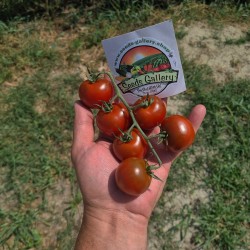
Semințe de roșii Campari
Pret
1,85 €
(SKU: VT 124)
Seeds Gallery EU,
5/
5
<h2 class=""><strong>Semințe de roșii Campari</strong></h2>
<h2><span style="color: #ff0000;"><strong>Preț pentru un pachet de 10 semințe.</strong></span></h2>
Campari este un tip de roșii, remarcat prin suculență, nivel ridicat de zahăr, aciditate scăzută și lipsa de gust. Camparis sunt de culoare roșu-negru și mai mari decât o roșie cherry, dar mai mici și mai rotunde decât o roșie de prune. Ele sunt adesea vândute ca „roșii pe viță” (TOV) în supermarketuri, o categorie de roșii care a devenit din ce în ce mai populară de-a lungul anilor. Roșiile Campari pot fi produse din diferite soiuri cu caracteristici similare, standardul fiind Mountain Magic. Ca hibrid, semințele costă în jur de 150.000 de dolari pe kilogram.<br><br>Compania Mastronardi Produce a înregistrat termenul „Campari” ca marcă comercială din Statele Unite pentru tomatele sale în 2003; cu toate acestea, marca a fost contestată în 2006 pe baza afirmațiilor că „Campari” este de fapt denumirea generală a soiului de roșii crescut în anii 1990 de către compania olandeză Enza Zaden.<br><br>Caracteristici<br>Un soi tipic Campari are formă de glob, cu frunze regulate și prezintă rezistență la virusul mozaicului tutunului. Planta crește 1,8-2,4 m și se maturizează în 70-80 de zile.
<script src="//cdn.public.n1ed.com/G3OMDFLT/widgets.js"></script>
VT 124 (10 S)

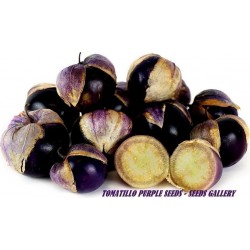
Tomatillo Seeds Physalis...
Pret
2,10 €
(SKU: VT 163 P)
Seeds Gallery EU,
5/
5
<h2><span style="text-decoration: underline; font-size: 10pt;" class=""><em><strong>Tomatillo Seeds Physalis philadelphica Purple</strong></em></span></h2>
<h3><span style="color: #ff0000; font-size: 10pt;"><strong>Price for Package of 5 seeds.</strong></span></h3>
<div><span style="font-size: 10pt;">One of the most popular and reliable tomatillo varieties delivering heavy crops on large determinate vines of rounded berries 1 to 2 inches in diameter enclosed in the thin husk of its extended calyx. The fruit ripens to a yellow colour, and has a delicious, sweet-tart flavour. Unique garden variety that's very popular in Mexican cuisine. Matures 65-75 days from germination.</span></div>
<div><span style="font-size: 10pt;">Sow in spring 1/16 inch deep. Germination takes around 6-14 days at 65-75F.</span></div>
<div><span style="font-size: 10pt;">Transplant the seedlings when large enough to handle into 3 inch pots. Grow on under cooler conditions and when about 8 inches tall, either plant in their growing position in the greenhouse or gradually acclimatise them to outdoor conditions and plant out at least 18 inches apart in a warm and sunny spot in moist, fertile well drained soil and keep watered.</span></div>
<div><span style="font-size: 10pt;">Provide support as the plants will naturally ramble. </span></div>
<script src="//cdn.public.n1ed.com/G3OMDFLT/widgets.js"></script>
VT 163 P (5 S)


Varietate din Italia
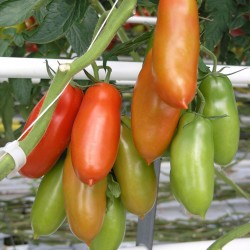
Semințe de roșii San...
Pret
2,85 €
(SKU: VT 166)
Seeds Gallery EU,
5/
5
<h2><strong>Semințe de roșii San Marzano Gigante (Gran Merito).</strong></h2>
<h2><span style="color: #ff0000;"><strong>Preț pentru un pachet de 10 semințe.</strong></span></h2>
<p>Roșia italiană San Marzano Gigante, este cunoscută și sub numele de „Gran Merito”. Frumosele fructe ovale cresc în ciorchini de 6 până la 10 fructe și au în medie 90 până la 120 g în greutate. Se coace la o culoare roșie într-o perioadă de aproximativ 65 până la 75 de zile după însămânțare.</p>
<p>Aceste roșii suculente și delicioase au o durată lungă de valabilitate și sunt folosite în salate și preparate reci, precum și pentru sosuri și preparate gătite.</p>
<p>Plantele puternice au o înălțime medie de 90 până la 100 cm și au un randament excelent. (Determină creșterea)</p>
<p>Roșia San Marzano Gigante nu este hibridă, fără tratament chimic, fără OMG și fără otravă.</p>
VT 166 (10 S)

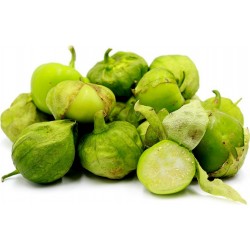
Tomatillo Seeds - Toma...
Pret
2,65 €
(SKU: VT 163 TV)
Seeds Gallery EU,
5/
5
<h2 class=""><strong>Tomatillo Seeds - Toma Verde (Physalis ixocarpa)</strong></h2>
<h2><span style="color: #ff0000;"><strong>Price for Package of 10 seeds.</strong></span></h2>
<p>Tomatillos are irreplaceable as a vegetable and part of salas, especially in Mexican cuisine, and cannot be replaced with green tomatoes. Tomatillos has the ability to thicken the sauce and soup, so other thickeners can be omitted.</p>
<p>The original distribution area of Tomatillo is Mexico. Therefore, vegetables are also called Mexican tomatoes or Mexican cherries. Tomatillo is a herbaceous and shrubby growing perennial plant with serrated leaves that can reach one to two meters in height.</p>
<p>Unlike other Phisalis species, Tomatillo is barely hairy. Its yellow flowers are dark brown to black in the middle. The champion-shaped bracts are green and purple at first and dry. Spherical fruits are like tomatoes, which are green, yellow or purple, depending on the variety. They have a sweet-sour aroma and are used for seasoning sauces, especially in Mexico and Central America. In addition, Tomatilo is mainly grown in the southern United States. Tomatillo is still relatively unknown. However, this could change quickly due to the relatively uncomplicated cultivation and their high yields.</p>
<p>As Tomatillo belongs to the plants of the tomato family, it forms its fruits best in a sheltered from the wind and in a sunny place, in loose and nutrient-rich soil. Areas with a winegrowing climate are particularly suitable for cultivation. Before planting, it proved useful to improve the soil with little compost.</p>
<p>Sowing</p>
<p>Tomatillos can be sown from mid-February to the end of March. The seeds are grown in seed pods on a window or in a greenhouse. To do this, sow the seeds in small pots with sowing soil and place them as light and warm as possible, ideally a germination temperature of 20 to 27 degrees Celsius. Keep seedlings that appear after about a week or two moistened with warm water. If the seedlings are large enough to touch, they are transferred to pots five to eight inches in size. Cure young plants in a warm and sunny place for about four to five weeks before planting them outside.</p>
<p>Unlike Andean berries, tomatillos depend not only on insect pollination but also on cross-pollinators, so at least two plants are required to harvest. Planting should be done in late May, when there is no more frost. Sow the plants very low, as the stems in contact with the soil will develop more roots. Keep the distance from plant to plant 80 x 80 centimeters, as plants grow abundantly. Regularly water the tomatillos and fertilize them every two weeks with a plant-based fertilizer, such as horse or other.</p>
<p>The first tomatillos are ready to harvest after about 70 days. The fruits grow so large that they split the protective membrane. Then they mature and fall to the ground. In some varieties, ripe fruits turn purple or golden yellow under the influence of light. The fruit is delicious sour-sweet, depending on the variety. The fruits can be eaten raw, but are mostly processed into salsa, sauces, sauces and soups. In their home country, Mexico, they are known as the main ingredient of "Salsa verde". But they can also be used in vegetable dishes. The fruits can be refrigerated for several days to several weeks.</p>
<p>You can grow Tomatillo for several years if you are wintering the plant indoors. However, since it is very sensitive to cold, it has only been grown for a year. If stored in a large flower pots, you should cut it two-thirds after harvest and hibernate in a bright place with a temperature of about ten degrees Fahrenheit. From March, you should gradually get used to the higher temperatures and sunshine before setting it outdoors.</p><script src="//cdn.public.n1ed.com/G3OMDFLT/widgets.js"></script>
VT 163 TV (10 S)






